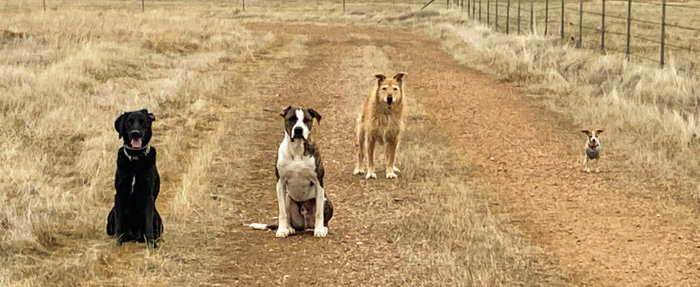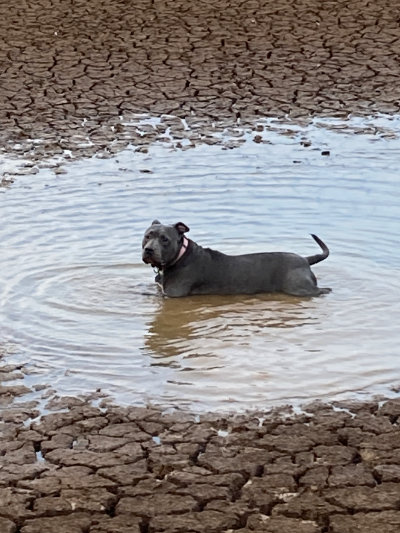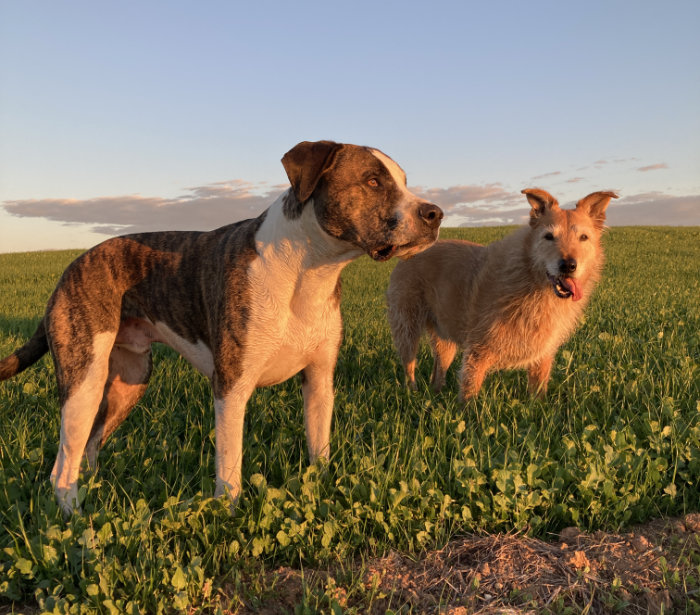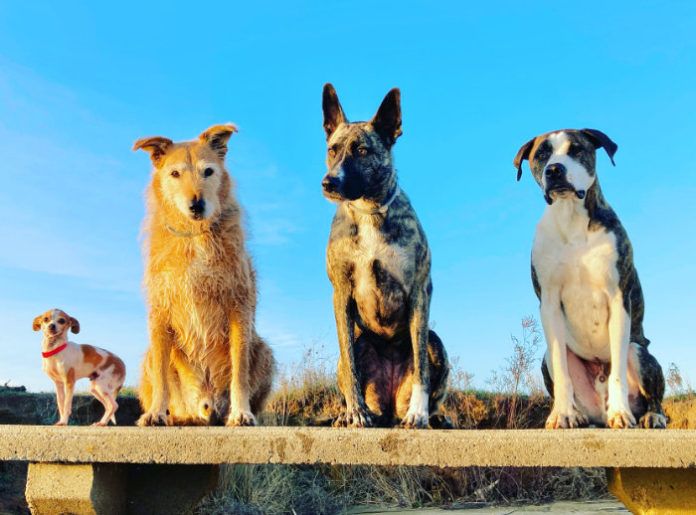My very favorite part of social media is seeing photos and videos of dogs having a good time outdoors. Lately, I’ve been seeing a lot of snow dogs: playing in it, hiking through it, skijoring over it! It looks great! But I’m glad I don’t live in a snowy area. The winter in my part of California gets cold, but not so cold that you need special clothes to enjoy a walk outside; a regular hoody and perhaps a down vest will do!
Walking in winter – my local version of winter, anyway – is absolutely my favorite. It’s not yet hot, the rattlesnakes are dormant, and the leash restrictions for the bird nesting season haven’t yet gone on. I live at the north end of the Sacramento Valley, in the middle of the great Pacific Flyway, a major north/south route for migratory birds, from Alaska to Patagonia. At this time of year, the skies and fields are full of migratory waterfowl, including millions of snow geese and small numbers of spectacular sandhill cranes – always exciting to spot. And we nearly always see year-round residents like the great blue heron, osprey, and several species of owls and hawks.
I’m extremely lucky: I live close to the Oroville Wildlife Area, about 11,000 acres of land alongside the Feather River and surrounding man-made bodies of water fed by the river: Lake Oroville and its “afterbay,” a shallow lake where freezing cold water from the bottom of Lake Oroville is warmed slightly before being released into nearby rice fields and fruit and nut orchards. Much of this land was mined for gold in the previous century using floating dredges as long as a city block. The tailings were mined again in the late 1950s and early ’60’s for the giant earth-filled Oroville Dam. What’s left of that land, much disturbed and still distinguished by piles of rock tailings and pockmarked with ponds that have filled in the holes left by the dredges, was finally protected for wildlife and recreation. There are two types of habitat in this area: some lowland savannah along the river, dotted with ancient oaks and filled with deer; and, farther from the river, open, grassy or marshy plains (depending on how close to the afterbay you are).

Dogs are allowed to walk off-leash in this area, except for during the nesting season, March 16 through the end of June. Actually, I start leashing up, or at least asking the dogs to stay on the trail, at the end of February, as some birds are already looking for nesting sites in the tall grass. When the leash restrictions go on, I generally start taking my dogs elsewhere to walk, usually on the dirt roads alongside the river in the more forested land, where nesting species are in trees, not on the ground. But, for as long as we can, I most enjoy these big-sky, open, grassy areas, and the dogs do, too.
Off-leash skills and good manners are requisite
Wherever we walk, we always practice a couple of skills that I feel are essential for any dog walked off-leash. If a dog hasn’t yet learned these skills to a pretty high degree of reliability, they don’t get to be off-leash. The two most important ones are a rock-solid recall (immediate and enthusiastic), and a good understanding of “off” or “leave it” (to forestall any interest in pursuing cattle on the other side of the wildlife area fence, or investigating that rattling noise coming from the grassy margin of the trail). We also practice a “distance sit” – parking their butts in place, either to allow someone to pass us on the trail (which happens incredibly rarely – again, I said I’m lucky to live here!) or to keep them still while I assess a possible threat (like a rattlesnake on the trail) or temptation (such as a deer crashing through the underbrush nearby). I ask them to practice each of these skills at least once per walk, and ALWAYS have high-value treats with me to generously reinforce these behaviors.

My usual walking partners include Nova, a former foster pup who was adopted by a young woman who is now a good friend; tiny Samson and his owner Leonora, who was fostering Samson’s litter for our local shelter while I was fostering Woody’s litter (and we both kept our favorite from the litter); and sometimes my friend Loran, who adopted a middle-aged hippo-style bully-breed mix, also adopted from my local shelter. (Another friend who owns one of my long-ago former foster dogs and two other dogs recently moved out of state.)
Of course, we were recently also accompanied by my foster dog Coco, who found a lovely home in Idaho and is doing very well there.
All of these dogs, of various ages and sexes and breeds, get along splendidly with my dogs, though there are behavioral differences between them. Otto doesn’t really socialize with the others on walks. He isn’t unfriendly, just splendidly indifferent to what the other dogs are doing. The behavior is very much mirrored by the older dogs: Chaco the Kelpie-mix former foster who moved away, and Betty the hippo/bully-breed mix. These three have always kept their own counsel. If they are approached at a high rate of speed by a younger dog, they tend to step out of the way and look the other way. (Although, in his increasingly arthritic old age, Otto will roar if someone bashes into him.)
Woody, who is now five years old, has long been the ringleader of the playful puppy set. He’s always down for running and romping and leaping and chasing and wrestling with anyone else who wants to do all that stuff. He’s been the “fun uncle” for countless foster pups who came and went, as well as the trail guide for our longer-term foster pups (including Odin, the former mangey pup who had to have an eye removed, and of course hoppy, happy little Coco). He and Nova, who is now two years old, still race and wrestle with wild abandon as we walk.
At not-quite five pounds, twiggy, long-legged Samson’s goal on these walks is mostly to not get run over. He’s figured out that the best way to do that is to either stay at our heels, or follow Otto very closely; those are safe spots. Samson shines at the sit-stay; we can leave him behind, sitting, until he’s practically a speck in the road (well, he’s very small). When called, he comes as fast as his twiggy legs will go; it’s fun to watch.

The distance-sit and stay is Kryptonite for Nova. At just over two years old, she’s still developing control over her impulses, and she gets squirmy and anxious if left behind, even if it’s just 20 feet or so from us. Her recall is super sharp, however. If it involves running, she’s excellent at it! Maybe these skills are age-related. Coco also never quite got the hang of either sitting or staying away from us. If she heard any cue that had once offered an opportunity to earn a treat, she’d come running and sit in front of us. Well, there are worse things!
Happy winter walks to you, too!







It’s a good article thank you for the information.
Thanks for taking me on a grand winter walk with you. Your dogs are blessed with such wide open spaces. 😘
Very much enjoyed this entry. Sent it to a friend who lives and walks her pack in central PA. How do I subscribe to the blog directly?
At the top of the page, there is a tab that says “Free Newsletter.”
It’s fun to enjoy the outdoors with our besties in every season! I agree, no rattlesnakes, foxtails, buzzing insects make this time of year more appealing.
I have even learned the pleasure of hiking in the rain from my tireless GSPs! If you are suitably geared up, rain hikes are great, and I rarely encounter anyone else but newts and banana slugs!
I got very nervous just seeing photos of tiny Sampson sitting out in the open. He’s a “sitting duck” so to speak for a raptor’s meal. Our friend had her chihuahua taken up while on a walk on the sidewalk in a local housing community. Luckily, since he was still attached by his leash, the bird couldn’t fly off with him. He had extensive puncture wounds, however, and needed expensive vet care. I never let my chi mix out in the open unless she’s on a leash and her yard is covered by a sunshade to prevent raptors from seeing her. I’ve seen a “Raptor Shield Puncture Resistant Pet Vest for Small Dogs” on Amazon but don’t know how effective they are. Worth looking into, though.
Im looking for my missing dog like the brindle and white one on your pics of winter walk they could b twins